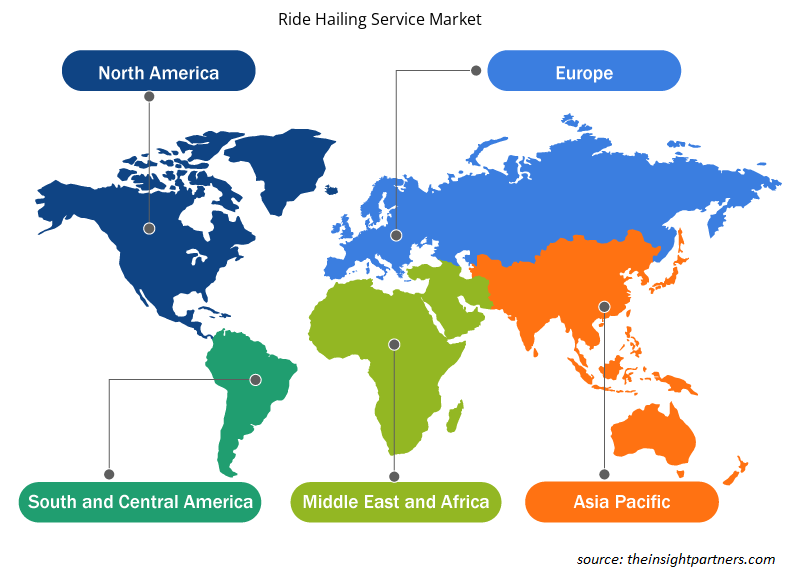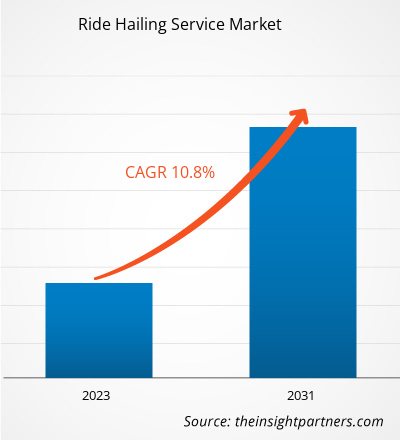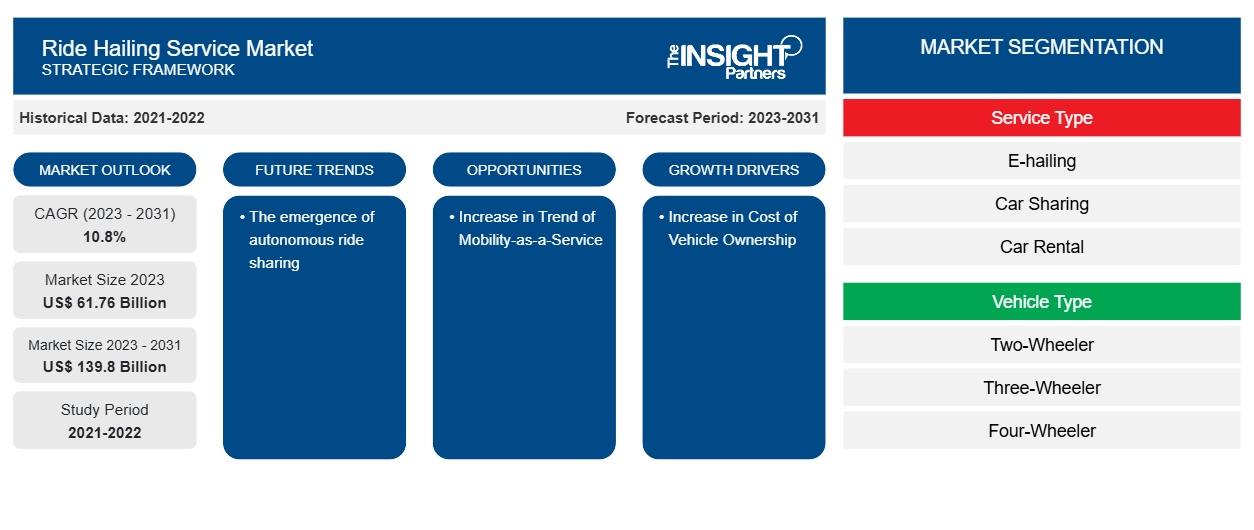Si prevede che la dimensione del mercato dei servizi di ride hailing raggiungerà i 139,8 miliardi di dollari entro il 2031, rispetto ai 61,76 miliardi di dollari del 2023. Si prevede che il mercato registrerà un CAGR del 10,8% nel periodo 2023-2031. È probabile che l'emergere del ride sharing autonomo rimanga una tendenza chiave nel mercato.CAGR of 10.8% during 2023–2031. The emergence of autonomous ride-sharing is likely to remain a key trend in the market.
Analisi del mercato dei servizi di ride hailing
Si prevede che l'aumento della tendenza dei servizi di trasporto su richiesta in tutto il mondo guiderà la crescita del mercato nei prossimi anni. Inoltre, si prevede che l'aumento del costo di proprietà del veicolo alimenterà la domanda di servizi di ride hailing durante il periodo di previsione. Inoltre, si prevede che un aumento della tendenza della mobilità come servizio in tutto il mondo spingerà ulteriormente la crescita del mercato dei servizi di ride hailing dal 2023 al 2031.
Panoramica del mercato dei servizi di ride hailing
Gli stakeholder chiave nell'ecosistema del mercato dei servizi di ride-hailing includono fornitori di soluzioni tecnologiche, fornitori di servizi di ride-hailing e utenti finali. I fornitori di soluzioni tecnologiche includono dispositivi connessi o altri produttori di hardware e sviluppatori di software. L'aumento del numero di fornitori di soluzioni tecnologiche sta guidando in modo critico la digitalizzazione nel ride-hailing. Si prevede che i servizi di ride-hailing aumenteranno dopo il COVID a causa della tendenza crescente dei servizi di trasporto su richiesta, della creazione di opportunità di lavoro e del basso tasso di proprietà di auto tra i millennial. Inoltre, i progressi tecnologici nei veicoli connessi e automatici per ridurre le emissioni di CO2 e gli aumenti sostanziali nelle vendite di questi veicoli intelligenti ed efficienti per l'uso dei servizi di ride-hailing spingono la crescita del mercato globale. I fornitori di servizi di ride-hailing prendono servizi dai fornitori di soluzioni tecnologiche. Con i crescenti sviluppi tecnologici nel ride-hailing, la domanda di un mercato di servizi di ride-hailing è in aumento.millennials. In addition, technological advancements in connected & automatic
Personalizza questo report in base alle tue esigenze
Riceverai la personalizzazione gratuita di qualsiasi report, comprese parti di questo report, o analisi a livello nazionale, pacchetto dati Excel, oltre a usufruire di grandi offerte e sconti per start-up e università
-
Scopri le principali tendenze di mercato in questo rapporto.Questo campione GRATUITO includerà analisi di dati che spaziano dalle tendenze di mercato alle stime e alle previsioni.
Driver e opportunità del mercato dei servizi di ride hailing
Aumento del costo di proprietà del veicolo a favore del mercato
Finanza, carburante, manutenzione, immatricolazione/tasse e manutenzione, nonché deprezzamento, contribuiscono tutti al costo di proprietà di un'auto. La spesa per possedere un veicolo aumenta di anno in anno. Il deprezzamento rappresenta oltre il 43% del costo totale di proprietà, secondo l'American Automobile Association (AAA). Tuttavia, gli altri costi, come manutenzione e benzina , rappresentano il 25%. L'aumento dei prezzi del carburante e dei costi di manutenzione è aumentato drasticamente negli ultimi 10 anni e si prevede che aumenterà nei prossimi anni. Sebbene la proprietà di auto sia aumentata durante la pandemia, si prevede che diminuirà dopo il 2021 e tornerà ai livelli pre-pandemia. Ciò consente ai fornitori di ride-hailing di beneficiare di questo sviluppo demografico, poiché la nuova generazione esperta di tecnologia è tra gli utenti più attivi di questi servizi.pre-pandemic levels. This allows ride-hailing providers to benefit from this demographic development, as the new technology-savvy generation is among the most active users of these services.
Aumento della tendenza della mobilità come servizio
I clienti che non sono in grado di acquistare il veicolo possono sperimentare un viaggio senza interruzioni attraverso i servizi di mobilità. La mobilità come servizio riduce i costi di proprietà e di esercizio massimizzando i costi del car sharing e del ride hailing. Inoltre, il rapido ritmo dell'urbanizzazione sta già portando alla congestione del traffico. Il concetto di mobilità come servizio (MaaS) potrebbe essere una scelta migliore per ridurre al minimo la congestione del traffico tramite un maggiore utilizzo della rete di trasporto pubblico e privato esistente. L'urgente e crescente domanda di soluzioni efficaci per gestire il traffico nelle città intelligenti che a sua volta dovrebbe alimentare la crescita del mercato dei servizi di ride hailing fino al 2031. Pertanto, si prevede che la tendenza crescente della mobilità come servizio (MaaS) alimenterà la crescita del mercato globale dei servizi di ride hailing.MaaS) concept may be a better choice for minimizing traffic congestion by greater use of existing public and private transportation network. The urgent and increased demand for effective solutions to handle traffic in smart cities which in turn is expected to fuel ride hailing service market growth through 2031. Therefore, the increasing trend of mobility as a Service (MaaS) is expected to fuel the growth of the global ride-hailing service market.
Analisi della segmentazione del rapporto di mercato del servizio di ride hailing
I segmenti chiave che hanno contribuito alla derivazione dell'analisi del mercato del servizio di ride hailing sono il tipo di servizio, il tipo di veicolo, la posizione e l'utente finale
- In base al tipo di servizio, il mercato dei servizi di ride hailing è suddiviso in E-hailing, car sharing, autonoleggio e mobilità basata sulle stazioni. Il segmento E-hailing ha detenuto la quota di mercato maggiore nel 2023.
- In base al tipo di veicolo, il mercato è segmentato in veicoli a due ruote, a tre ruote, a quattro ruote e altri. Il segmento dei veicoli a quattro ruote ha detenuto la quota maggiore del mercato nel 2023.
- In base alla posizione, il mercato è diviso in urbano e rurale. Il segmento urbano deteneva una quota significativa del mercato nel 2023.
- In base all'utente finale, il mercato è segmentato in istituzionale e personale. Il segmento istituzionale ha detenuto la quota maggiore del mercato nel 2023.
Analisi della quota di mercato del servizio di ride hailing per area geografica
L'ambito geografico del rapporto sul mercato dei servizi di ride hailing è suddiviso principalmente in cinque regioni: Nord America, Asia Pacifico, Europa, Medio Oriente e Africa e Sud America.
L'ambito del rapporto sul mercato dei servizi di ride hailing comprende Nord America (Stati Uniti, Canada e Messico), Europa (Germania, Francia, Italia, Spagna, Regno Unito e resto d'Europa), Asia Pacifico (Cina, India, Australia, Giappone, Corea del Sud e resto dell'Asia Pacifico), Medio Oriente e Africa (Sudafrica, Arabia Saudita, Emirati Arabi Uniti e resto del Medio Oriente e Africa) e Sud America (Brasile, Argentina e resto del Sud America). In termini di fatturato, l'Asia Pacifico ha dominato la quota di mercato dei servizi di ride hailing nel 2023. Il Nord America è stato il secondo maggiore contributore di fatturato al mercato globale dei servizi di ride hailing, seguito dall'Europa.
Approfondimenti regionali sul mercato dei servizi di ride hailing
Le tendenze regionali e i fattori che influenzano il mercato dei servizi di ride hailing durante il periodo di previsione sono stati ampiamente spiegati dagli analisti di Insight Partners. Questa sezione discute anche i segmenti e la geografia del mercato dei servizi di ride hailing in Nord America, Europa, Asia Pacifico, Medio Oriente e Africa e Sud e Centro America.

- Ottieni i dati specifici regionali per il mercato dei servizi di ride hailing
Ambito del rapporto sul mercato dei servizi di ride hailing
| Attributo del report | Dettagli |
|---|---|
| Dimensioni del mercato nel 2023 | 61,76 miliardi di dollari USA |
| Dimensioni del mercato entro il 2031 | 139,8 miliardi di dollari USA |
| CAGR globale (2023-2031) | 10,8% |
| Dati storici | 2021-2022 |
| Periodo di previsione | 2023-2031 |
| Segmenti coperti |
Per tipo di servizio
|
| Regioni e Paesi coperti |
America del Nord
|
| Leader di mercato e profili aziendali chiave |
|
Densità degli attori del mercato: comprendere il suo impatto sulle dinamiche aziendali
Il mercato del Ride Hailing Service Market sta crescendo rapidamente, spinto dalla crescente domanda degli utenti finali dovuta a fattori quali l'evoluzione delle preferenze dei consumatori, i progressi tecnologici e una maggiore consapevolezza dei vantaggi del prodotto. Con l'aumento della domanda, le aziende stanno ampliando le loro offerte, innovando per soddisfare le esigenze dei consumatori e capitalizzando sulle tendenze emergenti, il che alimenta ulteriormente la crescita del mercato.
La densità degli operatori di mercato si riferisce alla distribuzione di aziende o società che operano in un particolare mercato o settore. Indica quanti concorrenti (operatori di mercato) sono presenti in un dato spazio di mercato in relazione alle sue dimensioni o al valore di mercato totale.
Le principali aziende che operano nel mercato dei servizi di ride hailing sono:
- ANI Technologies Società a responsabilità limitata
- Società Agricola Daimler
- Delphi Technologies PLC
- DiDi Global Inc.
- Ottenere
- Società per azioni Grab Holdings Inc.
Disclaimer : le aziende elencate sopra non sono classificate secondo un ordine particolare.

- Ottieni una panoramica dei principali attori del mercato dei servizi di ride hailing
Notizie e sviluppi recenti sul mercato dei servizi di ride hailing
Il mercato dei servizi di ride hailing viene valutato raccogliendo dati qualitativi e quantitativi dopo la ricerca primaria e secondaria, che include importanti pubblicazioni aziendali, dati associativi e database. Di seguito sono elencati alcuni degli sviluppi nel mercato dei servizi di ride hailing:
- Il fornitore di servizi di ride hailing Kakao Mobility ha ampliato la propria presenza lanciando servizi di ride hailing in Asia e Medio Oriente. (Fonte: Kakao Mobility, comunicato stampa, novembre 2023)
- DiDi Global Inc. ha avviato il processo di registrazione degli autisti a Città del Capo, in Sudafrica, e ha iniziato a fornire servizi di ride-hailing ai consumatori nella seconda città più grande del Paese. (Fonte: DiDi Global Inc., comunicato stampa, marzo 2021)
Copertura e risultati del rapporto sul mercato dei servizi di ride hailing
Il rapporto "Dimensioni e previsioni del mercato dei servizi di ride hailing (2021-2031)" fornisce un'analisi dettagliata del mercato che copre le seguenti aree:
- Dimensioni e previsioni del mercato dei servizi di ride hailing a livello globale, regionale e nazionale per tutti i principali segmenti di mercato coperti dall'ambito
- Tendenze del mercato dei servizi di ride hailing e dinamiche di mercato come conducenti, restrizioni e opportunità chiave
- Analisi PEST e SWOT dettagliate
- Analisi di mercato del servizio di ride hailing che copre le principali tendenze del mercato, il quadro globale e regionale, i principali attori, le normative e i recenti sviluppi del mercato
- Analisi del panorama del settore e della concorrenza che copre la concentrazione del mercato, l'analisi della mappa di calore, i principali attori e gli sviluppi recenti per il mercato dei servizi di ride hailing
- Profili aziendali dettagliati
- Analisi storica (2 anni), anno base, previsione (7 anni) con CAGR
- Analisi PEST e SWOT
- Valore/volume delle dimensioni del mercato - Globale, Regionale, Nazionale
- Industria e panorama competitivo
- Set di dati Excel
Report recenti
Testimonianze
Motivo dell'acquisto
- Processo decisionale informato
- Comprensione delle dinamiche di mercato
- Analisi competitiva
- Analisi dei clienti
- Previsioni di mercato
- Mitigazione del rischio
- Pianificazione strategica
- Giustificazione degli investimenti
- Identificazione dei mercati emergenti
- Miglioramento delle strategie di marketing
- Aumento dell'efficienza operativa
- Allineamento alle tendenze normative























 Ottieni un campione gratuito per - Mercato dei servizi di ride hailing
Ottieni un campione gratuito per - Mercato dei servizi di ride hailing